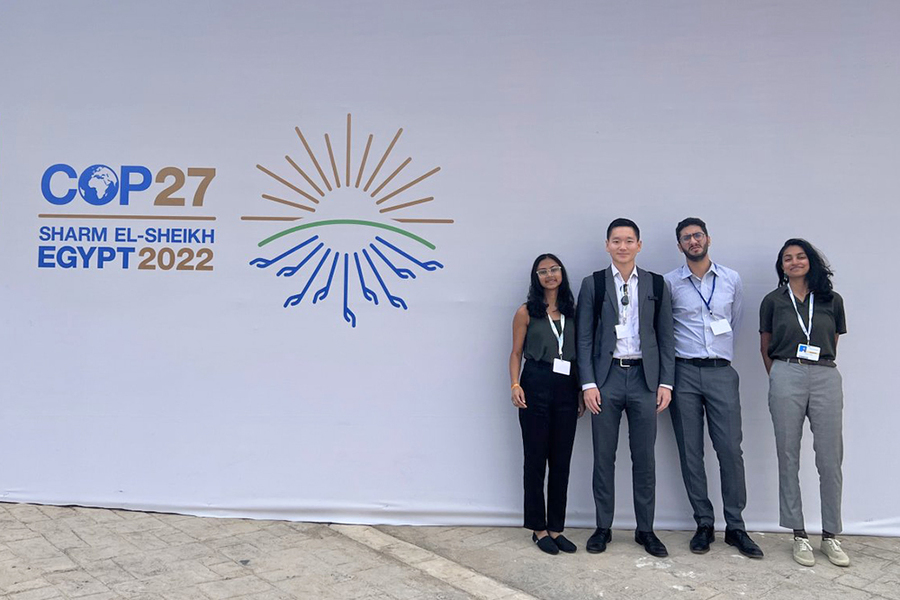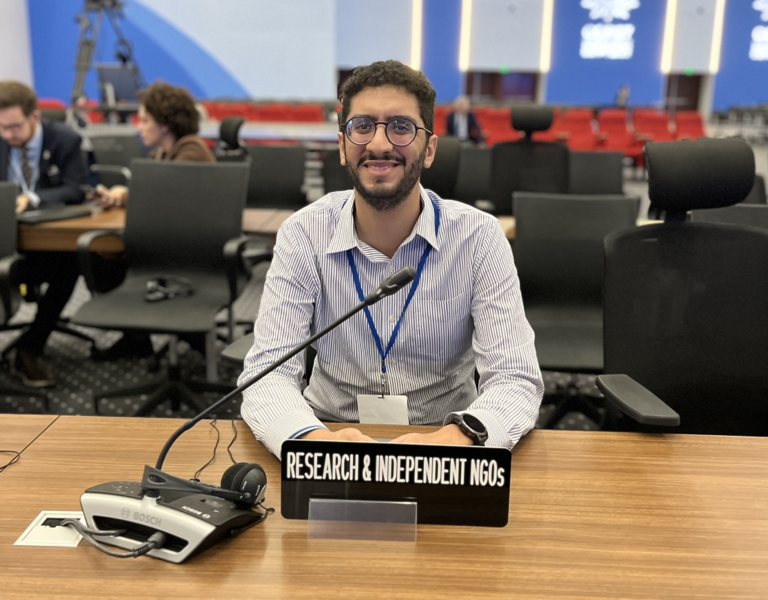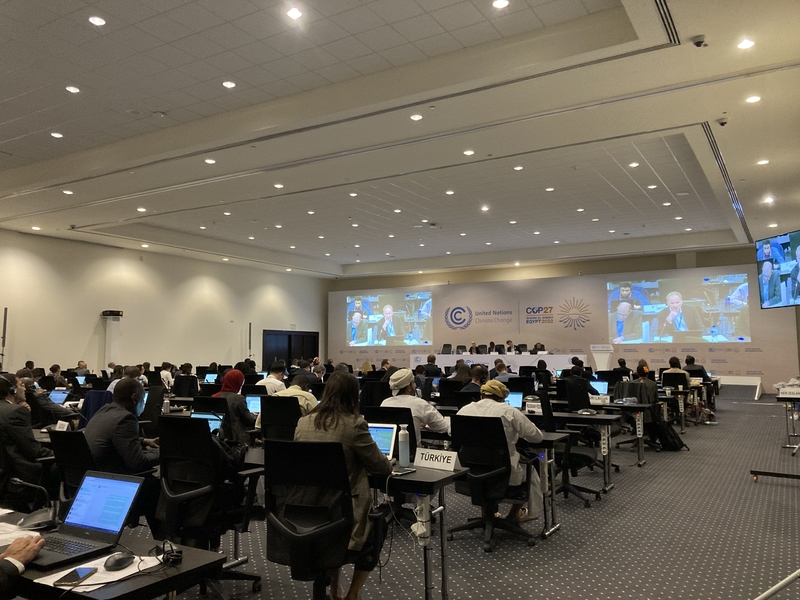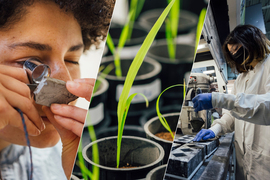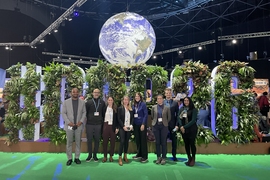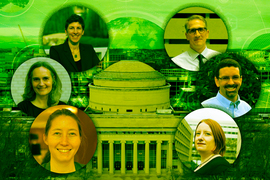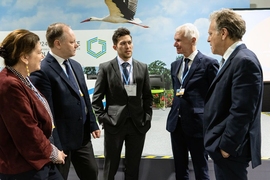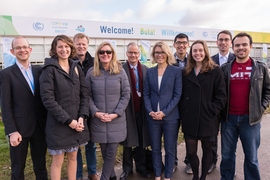As the 2022 United Nations climate change conference, known as COP27, stretched into its final hours on Saturday, Nov. 19, it was uncertain what kind of agreement might emerge from two weeks of intensive international negotiations.
In the end, COP27 produced mixed results: on the one hand, a historic agreement for wealthy countries to compensate low-income countries for “loss and damage,” but on the other, limited progress on new plans for reducing the greenhouse gas emissions that are warming the planet.
“We need to drastically reduce emissions now — and this is an issue this COP did not address,” said U.N. Secretary-General António Guterres in a statement at the conclusion of COP27. “A fund for loss and damage is essential — but it’s not an answer if the climate crisis washes a small island state off the map — or turns an entire African country to desert.”
Throughout the two weeks of the conference, a delegation of MIT students, faculty, and staff was at the Sharm El-Sheikh International Convention Center to observe the negotiations, conduct and share research, participate in panel discussions, and forge new connections with researchers, policymakers, and advocates from around the world.
Loss and damage
A key issue coming in to COP27 (COP stands for “conference of the parties” to the U.N. Framework Convention on Climate Change, held for the 27th time) was loss and damage: a term used by the U.N. to refer to harms caused by climate change — either through acute catastrophes like extreme weather events or slower-moving impacts like sea level rise — to which communities and countries are unable to adapt.
Ultimately, a deal on loss and damage proved to be COP27’s most prominent accomplishment. Negotiators reached an eleventh-hour agreement to “establish new funding arrangements for assisting developing countries that are particularly vulnerable to the adverse effects of climate change.”
“Providing financial assistance to developing countries so they can better respond to climate-related loss and damage is not only a moral issue, but also a pragmatic one,” said Michael Mehling, deputy director of the MIT Center for Energy and Environmental Policy Research, who attended COP27 and participated in side events. “Future emissions growth will be squarely centered in the developing world, and offering support through different channels is key to building the trust needed for more robust global cooperation on mitigation.”
Youssef Shaker, a graduate student in the MIT Technology and Policy Program and a research assistant with the MIT Energy Initiative, attended the second week of the conference, where he followed the negotiations over loss and damage closely.
“While the creation of a fund is certainly an achievement,” Shaker said, “significant questions remain to be answered, such as the size of the funding available as well as which countries receive access to it.” A loss-and-damage fund that is not adequately funded, Shaker noted, “would not be an impactful outcome.”
The agreement on loss and damage created a new committee, made up of 24 country representatives, to “operationalize” the new funding arrangements, including identifying funding sources. The committee is tasked with delivering a set of recommendations at COP28, which will take place next year in Dubai.
Advising the U.N. on net zero
Though the decisions reached at COP27 did not include major new commitments on reducing emissions from the combustion of fossil fuels, the transition to a clean global energy system was nevertheless a key topic of conversation throughout the conference.
The Council of Engineers for the Energy Transition (CEET), an independent, international body of engineers and energy systems experts formed to provide advice to the U.N. on achieving net-zero emissions globally by 2050, convened for the first time at COP27. Jessika Trancik, a professor in the MIT Institute for Data, Systems, and Society and a member of CEET, spoke on a U.N.-sponsored panel on solutions for the transition to clean energy.
Trancik noted that the energy transition will look different in different regions of the world. “As engineers, we need to understand those local contexts and design solutions around those local contexts — that’s absolutely essential to support a rapid and equitable energy transition.”
At the same time, Trancik noted that there is now a set of “low-cost, ready-to-scale tools” available to every region — tools that resulted from a globally competitive process of innovation, stimulated by public policies in different countries, that dramatically drove down the costs of technologies like solar energy and lithium-ion batteries. The key, Trancik said, is for regional transition strategies to “tap into global processes of innovation.”
Reinventing climate adaptation
Elfatih Eltahir, the H. M. King Bhumibol Professor of Hydrology and Climate, traveled to COP27 to present plans for the Jameel Observatory Climate Resilience Early Warning System (CREWSnet), one of the five projects selected in April 2022 as a flagship in MIT’s Climate Grand Challenges initiative. CREWSnet focuses on climate adaptation, the term for adapting to climate impacts that are unavoidable.
The aim of CREWSnet, Eltahir told the audience during a panel discussion, is “nothing short of reinventing the process of climate change adaptation,” so that it is proactive rather than reactive; community-led; data-driven and evidence-based; and so that it integrates different climate risks, from heat waves to sea level rise, rather than treating them individually.
“However, it’s easy to talk about these changes,” said Eltahir. “The real challenge, which we are now just launching and engaging in, is to demonstrate that on the ground.” Eltahir said that early demonstrations will happen in a couple of key locations, including southwest Bangladesh, where multiple climate risks — rising sea levels, increasing soil salinity, and intensifying heat waves and cyclones — are combining to threaten the area’s agricultural production.
Building on COP26
Some members of MIT’s delegation attended COP27 to advance efforts that had been formally announced at last year’s U.N. climate conference, COP26, in Glasgow, Scotland.
At an official U.N. side event co-organized by MIT on Nov. 11, Greg Sixt, the director of the Food and Climate Systems Transformation (FACT) Alliance led by the Abdul Latif Jameel Water and Food Systems Lab, provided an update on the alliance’s work since its launch at COP26.
Food systems are a major source of greenhouse gas emissions — and are increasingly vulnerable to climate impacts. The FACT Alliance works to better connect researchers to farmers, food businesses, policymakers, and other food systems stakeholders to make food systems (which include food production, consumption, and waste) more sustainable and resilient.
Sixt told the audience that the FACT Alliance now counts over 20 research and stakeholder institutions around the world among its members, but also collaborates with other institutions in an “open network model” to advance work in key areas — such as a new research project exploring how climate scenarios could affect global food supply chains.
Marcela Angel, research program director for the Environmental Solutions Initiative (ESI), helped convene a meeting at COP27 of the Afro-InterAmerican Forum on Climate Change, which also launched at COP26. The forum works with Afro-descendant leaders across the Americas to address significant environmental issues, including climate risks and biodiversity loss.
At the event — convened with the Colombian government and the nonprofit Conservation International — ESI brought together leaders from six countries in the Americas and presented recent work that estimates that there are over 178 million individuals who identify as Afro-descendant living in the Americas, in lands of global environmental importance.
“There is a significant overlap between biodiversity hot spots, protected areas, and areas of high Afro-descendant presence,” said Angel. “But the role and climate contributions of these communities is understudied, and often made invisible.”
Limiting methane emissions
Methane is a short-lived but potent greenhouse gas: When released into the atmosphere, it immediately traps about 120 times more heat than carbon dioxide does. More than 150 countries have now signed the Global Methane Pledge, launched at COP26, which aims to reduce methane emissions by at least 30 percent by 2030 compared to 2020 levels.
Sergey Paltsev, the deputy director of the Joint Program on the Science and Policy of Global Change and a senior research scientist at the MIT Energy Initiative, gave the keynote address at a Nov. 17 event on methane, where he noted the importance of methane reductions from the oil and gas sector to meeting the 2030 goal.
“The oil and gas sector is where methane emissions reductions could be achieved the fastest,” said Paltsev. “We also need to employ an integrated approach to address methane emissions in all sectors and all regions of the world because methane emissions reductions provide a near-term pathway to avoiding dangerous tipping points in the global climate system.”
“Keep fighting relentlessly”
Arina Khotimsky, a senior majoring in materials science and engineering and a co-president of the MIT Energy and Climate Club, attended the first week of COP27. She reflected on the experience in a social media post after returning home.
“COP will always have its haters. Is there greenwashing? Of course! Is everyone who should have a say in this process in the room? Not even close,” wrote Khotimsky. “So what does it take for COP to matter? It takes everyone who attended to not only put ‘climate’ on front-page news for two weeks, but to return home and keep fighting relentlessly against climate change. I know that I will.”
